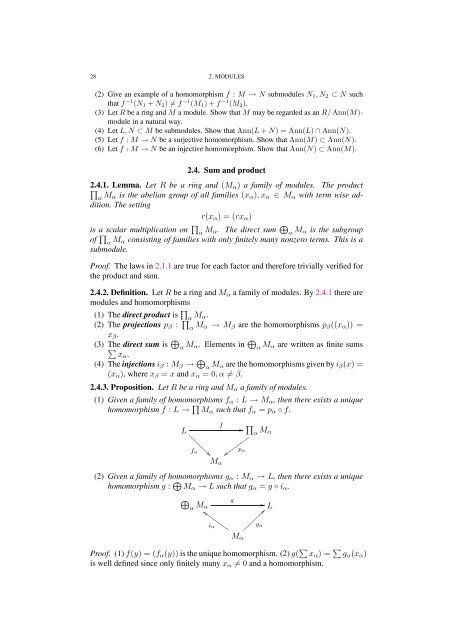Commutative algebra - Department of Mathematical Sciences - old ...
Commutative algebra - Department of Mathematical Sciences - old ...
Commutative algebra - Department of Mathematical Sciences - old ...
Create successful ePaper yourself
Turn your PDF publications into a flip-book with our unique Google optimized e-Paper software.
28 2. MODULES<br />
(2) Give an example <strong>of</strong> a homomorphism f : M → N submodules N1, N2 ⊂ N such<br />
that f −1 (N1 + N2) = f −1 (M1) + f −1 (M2).<br />
(3) Let R be a ring and M a module. Show that M may be regarded as an R/ Ann(M)module<br />
in a natural way.<br />
(4) Let L, N ⊂ M be submodules. Show that Ann(L + N) = Ann(L) ∩ Ann(N).<br />
(5) Let f : M → N be a surjective homomorphism. Show that Ann(M) ⊂ Ann(N).<br />
(6) Let f : M → N be an injective homomorphism. Show that Ann(N) ⊂ Ann(M).<br />
2.4. Sum and product<br />
2.4.1.<br />
<br />
Lemma. Let R be a ring and (Mα) a family <strong>of</strong> modules. The product<br />
α Mα is the abelian group <strong>of</strong> all families (xα), xα ∈ Mα with term wise addition.<br />
The setting<br />
r(xα) = (rxα)<br />
is a scalar multiplication on <br />
α Mα. The direct sum <br />
α Mα is the subgroup<br />
<strong>of</strong> <br />
α Mα consisting <strong>of</strong> families with only finitely many nonzero terms. This is a<br />
submodule.<br />
Pro<strong>of</strong>. The laws in 2.1.1 are true for each factor and therefore trivially verified for<br />
the product and sum.<br />
2.4.2. Definition. Let R be a ring and Mα a family <strong>of</strong> modules. By 2.4.1 there are<br />
modules and homomorphisms<br />
(1) The direct product is <br />
α Mα.<br />
(2) The projections pβ : <br />
α Mα → Mβ are the homomorphisms pβ((xα)) =<br />
xβ.<br />
(3) The direct sum is <br />
α Mα. Elements in <br />
α Mα <br />
are written as finite sums<br />
xα.<br />
(4) The injections iβ : Mβ → <br />
α Mα are the homomorphisms given by iβ(x) =<br />
(xα), where xβ = x and xα = 0, α = β.<br />
2.4.3. Proposition. Let R be a ring and Mα a family <strong>of</strong> modules.<br />
(1) Given a family <strong>of</strong> homomorphisms fα : L → Mα, then there exists a unique<br />
homomorphism f : L → Mα such that fα = pα ◦ f.<br />
L <br />
<br />
fα <br />
<br />
f<br />
Mα<br />
pα<br />
<br />
<br />
<br />
α Mα<br />
(2) Given a family <strong>of</strong> homomorphisms gα : Mα → L, then there exists a unique<br />
homomorphism g : Mα → L such that gα = g ◦ iα.<br />
<br />
α Mα<br />
g<br />
<br />
<br />
<br />
<br />
<br />
iα <br />
gα<br />
<br />
Mα<br />
Pro<strong>of</strong>. (1) f(y) = (fα(y)) is the unique homomorphism. (2) g( xα) = gα(xα)<br />
is well defined since only finitely many xα = 0 and a homomorphism.<br />
L
















